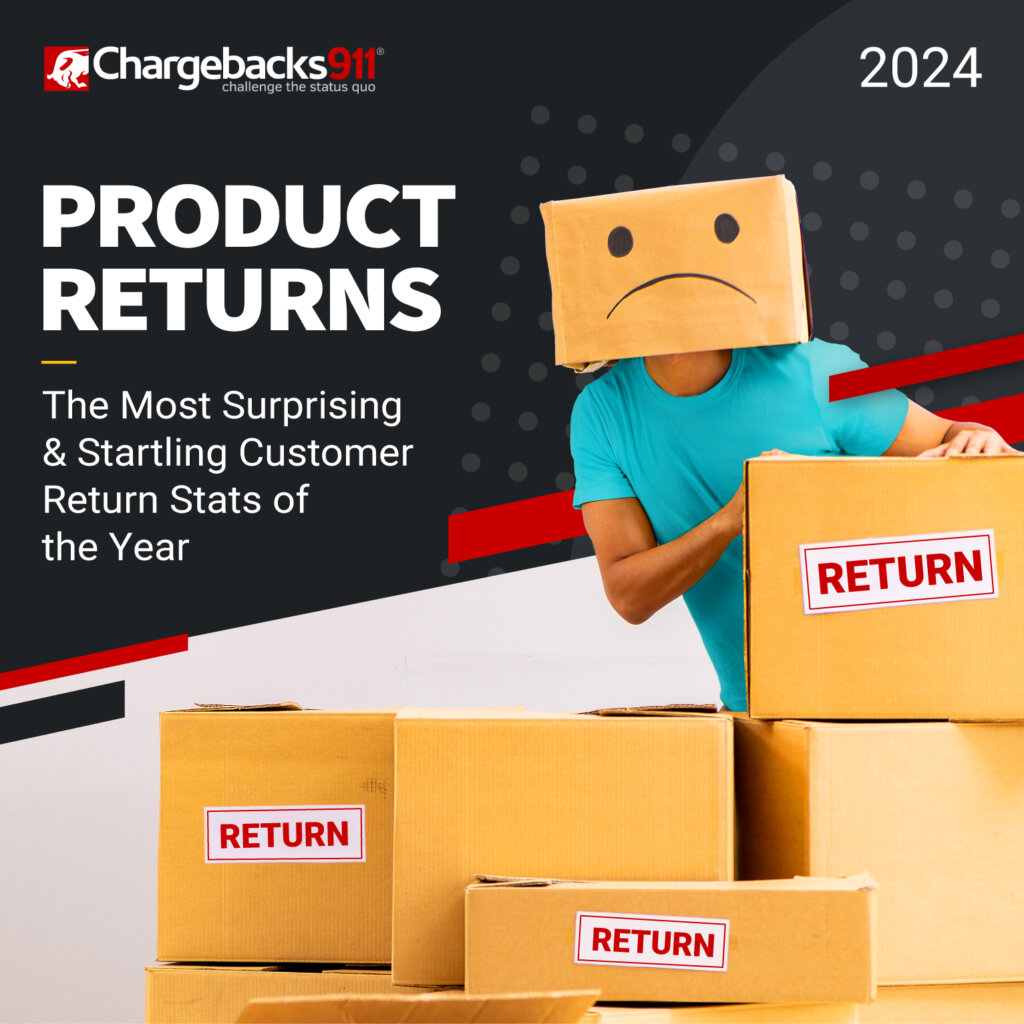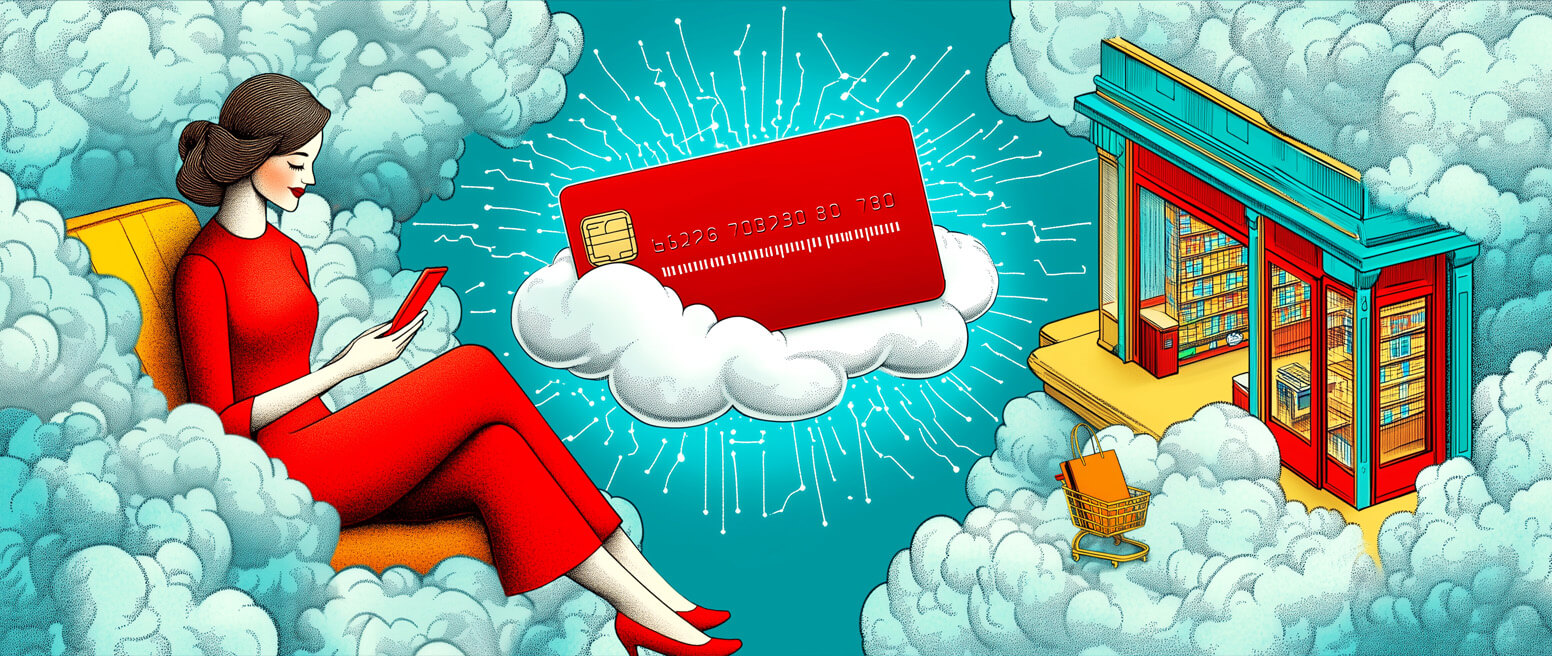Top 15 Reasons Customers Return Your Merchandise (& What to Do About it)
Why do customers return items? It could be something minuscule that you may have overlooked at the individual order level. Sometimes, though, it’s a more serious issue that demands immediate attention, like faulty policies or system errors.
Other times…the return might have nothing to do with your products or policies at all.
In this article, we’ll take a deep dive into customer returns. We’ll explore the top reasons why they happen. We’ll also see how streamlining your return process could help you avoid friendly fraud and other sticky situations.
Recommended reading
- Write an eCommerce Return Policy: Best Practices & Templates
- Card-Not-Present Transactions: Know the Risks & Rewards
- Online Shopping vs In-Store Shopping: the Future of Retail?
- They’re Here — Cyber Week 2024 Stats & Analysis!
- What is a Return Customer Rate? How to Calculate Your RCR
- Prime Day 2024: How to Avoid Chargebacks on the Big Day
The State of Product Returns in 2024
Let’s get this out of the way first: you’re going to receive the occasional customer return request.
Customer returns are an unavoidable part of doing business in most verticals. That doesn’t mean they aren’t also a major drain on your resources, though.
The National Retail Federation estimates consumers returned products worth a staggering $817 billion in 2023; just over 16% of total retail sales. If we dive a bit deeper into the numbers, we can see some interesting facts about customer returns emerge:

Top 15 Reasons Why Customer Returns Happen
Understanding why customer returns happen allows you to create policies that keep return rates in check, while reducing the risk of friendly fraud chargebacks. It’s also important to distinguish between acceptable reasons for returns and potential return fraud.
Here are some of the most common reasons for customer returns and what you can do about them:
The Problem
Purchasing the wrong item is especially pervasive in eCommerce because the consumer can’t physically handle the product. For example, the shopper might buy a pair of shoes and later realize they are the wrong size.
The Solution
Because there is no physical contact prior to purchase, online shoppers rely even more heavily on accurate and detailed product descriptions. Therefore, all product and service descriptions need to be as precise and definitive as possible.
The Problem
Consumers sometimes discover they don't need certain merchandise shortly after a purchase. Phone cases, chargers, and other accessories commonly fall into this category, as technology updates or broken devices may cancel out the need for an item. Other circumstances in the buyer's life—moving, downsizing, getting married, or changing jobs—might also cause them to return merchandise.
The Solution
First, try highlighting the item's distinguishing features in the product description. This may convince buyers to keep the product. Alternatively, try offering customers an exchange discount. For example, provide a 10-20% added purchase credit if the customer exchanges the item for something else instead of returning it for cash.
The Problem
Products that don’t measure up to consumers’ expectations are typically returned. This is similar to situations in which the customer buys the wrong item. In this instance, though, you can’t really blame the customer.
The Solution
You have to be careful about the language you use when promoting goods and services. Avoid overselling or overstating a product’s capabilities and functions. You can highlight a product or service, but at the end of the day, the description must realistically reflect that item’s qualities. You should make your merchandise look good…but not too good.
The Problem
If a buyer is purchasing a gift for someone else, they may not be very familiar with the product or service. They also may not fully understand the recipient's needs, tastes, or wishes. This can easily lead to customer returns and can be difficult to prevent.
The Solution
One suggestion might be to offer alternative or complementary product ideas to help educate inexperienced shoppers. Curated gift guides are a popular idea, especially around the holidays, as they allow shoppers to select relevant items based on recipients’ interests. Of course, promoting gift cards can make the process easy on everyone as well.
This may also be a situation in which that 10-20% added purchase credit for exchanges, rather than cash returns, can help recover sales.
The Problem
Customers will be understandably upset if an item they paid for is damaged or defective upon arrival. In these cases, a return is actually the best possible outcome; sometimes, the cardholder will turn to a chargeback instead, which you want to avoid at all costs.
The Solution
You can try and prevent customer returns due to damages by:
- Having a system in place to double-check any items being shipped.
- Carefully packaging all merchandise.
- Partnering only with reputable shipping and fulfillment companies.
- Using shipping insurance to help keep losses to a minimum.
Of course, accidents can still happen even with these mechanisms in place. That’s why you need to promote a ‘satisfaction guarantee’ to let customers know upfront that you'll work with them to resolve any issues.
The Problem
Consumers have every right to be frustrated in this situation. But unlike a damaged item, you can’t shift blame to a careless handler. There was an error committed in-house, during the order fulfillment process.
The Solution
Promoting customer return policies online can also help users know what to expect. This can reassure agitated buyers and make them more likely to request a return than file a chargeback.
Finally, be sure that your live customer service staff are well-trained to handle these scenarios. A positive customer service interaction could mean the difference between a happy customer and a chargeback.
The Problem
Clothing and footwear are often returned because they don't fit properly. This can be due to variations in sizing between brands or discrepancies in size charts.
The Solution
Give your customers detailed sizing charts, customer reviews, and fit guides on your product pages. You should also encourage them to read these resources before making a purchase to reduce the likelihood of returns due to poor fit.
Additionally, offering virtual fitting tools or customer service consultations can help mitigate these issues by guiding customers to the right size before they buy.
The Problem
A customer might return an item if they find a better deal elsewhere after making a purchase. This is common in competitive markets where prices fluctuate frequently, and merchants conduct frequent promotions to undercut competition.
The Solution
Offer a price match guarantee to reassure customers that they are getting the best deal. This can help reduce returns and build customer loyalty. Also, maintaining competitive, dynamic pricing can encourage customers to feel confident in their purchase, reducing the impulse to return items in search of better deals.
The Problem
Customers may return items if they feel the quality doesn't match what was advertised. The customer may even be agitated, and feel that they were the victim of a “bait-and-switch” scam. This can lead to disappointment and a lack of trust in your brand.
The Solution
Check that your product descriptions and images accurately reflect the quality of the items. Consider adding quality assurance checks before products are shipped to maintain high standards. Providing customer reviews and ratings can also help set accurate expectations for new buyers, thereby reducing returns due to unmet expectations.
The Problem
Sometimes, customers simply change their minds after purchasing an item. This is common with impulse buys or non-essential items. It’s an example of what is commonly known as “buyer’s remorse.”
The Solution
Implement a flexible return policy that accommodates customers who change their minds. Offering hassle-free returns can improve customer satisfaction and encourage repeat business, opening the opportunity to recover that sale later. You can also chat with these customers through follow-up emails or surveys to understand their reasons and potentially offer alternative products that might better suit their needs.
The Problem
Customers may accidentally purchase duplicate items, especially during busy shopping seasons or sales events. This could happen because of a temporary glitch, or due to a mistake on the part of the buyer.
The Solution
Before processing a return, offer the customer an exchange option or suggest other complementary products they might need. This can help retain the sale and provide a better customer experience. Highlighting unique selling points or related products at checkout can also help prevent duplicate purchases by guiding customers to make better-informed decisions.
The Problem
Delays in shipping can cause customers to return items that arrived too late for their intended use. For example, items purchased as gifts, or seasonal or event-specific purchases.
The Solution
Improve your shipping processes and provide accurate delivery estimates at the time of purchase. Offering expedited shipping options can also help meet tight deadlines and reduce late deliveries. Clear communication about shipping times and proactive updates on order status can further assure customers that their purchases will arrive on time, reducing returns due to delays.
The Problem
Negative experiences with customer service can lead to returns, as customers may lose confidence in your brand. They may even demand refunds out of spite, if the experience is perceived as being poor enough.
The Solution
Invest in training your customer service team to handle issues professionally and efficiently. Give them the tools and knowledge needed to resolve customer concerns promptly. Encourage a customer-first attitude and provide agents with the authority to resolve issues on the spot. This can turn negative experiences into positive ones, hopefully reducing returns in the long run.
The Problem
Sometimes, customers receive products that are entirely different from what they ordered due to fulfillment errors.
The Solution
Implement strict quality control measures in your order fulfillment process to ensure accuracy. Quickly resolve any discrepancies by offering prompt exchanges or refunds to maintain customer trust. Investing in inventory management systems and thorough staff training can help minimize errors so your customers receive exactly what they ordered.
The Problem
Return fraud is one of the fastest-growing problems facing retailers today. One common return fraud tactic is wardrobing, in which the cardholder buys an item, uses it, then attempts to return the item for a full refund. Other common tactics include receipt switching, shoplisting, and receipt fraud.
The Solution
It’s difficult to eliminate return fraud. Tightening security on all returns will frustrate legitimate customers, not just fraudsters. But, you can adopt practices like using historical data, verifying ID, and refusing cash refunds to deter some fraud activity.
An explicitly detailed policy that outlines acceptable returns can help you dispute any fraud attempts that devolve into chargebacks. You should also keep detailed communication records, as they can be used as compelling evidence in the event of a dispute.
10 Tips to Prevent Customer Returns
Naturally, you can’t stop all returns from happening. But, you can limit their frequency by implementing a few best practices. Remember, the goal is to save time and money and improve your overall customer satisfaction.
To that end, here are 10 best practices that can help you get started:
#1 | Provide Detailed, Accurate Descriptions
Clear and comprehensive product descriptions help customers know exactly what they are buying, reducing the chances of returns due to unmet expectations. Include all essential details such as size, color, material, and features. Use bullet points for easy readability and update descriptions regularly based on customer feedback to ensure they are always accurate.
#2 | Use High-Quality Images & Videos
Visuals are crucial in eCommerce as they help customers get a realistic view of the product. Invest in professional photography and videography. Show the product from multiple angles, use zoom features, and include videos that demonstrate the product in use to give a complete picture.
#3 | Offer Detailed Sizing Guides & Fit Information
Accurate sizing information helps customers choose the right size, which is especially important for clothing and footwear. Provide detailed size charts and fit guides. Include customer reviews that mention sizing and offer virtual fitting tools or live customer support to help customers make the right choice.
#4 | Encourage Customer Reviews & Feedback
Reviews provide social proof and help set realistic expectations for other customers. Make it easy for customers to leave reviews on your site. Highlight detailed reviews that discuss size, fit, and quality. Respond to reviews to show that you value feedback and are willing to address issues.
#5 | Implement Quality Control Measures
Making sure your products are of the highest possible quality before shipping reduces returns due to defects or damage. Establish a strict quality control process. Inspect products before they are shipped, address any issues immediately, and work with reliable suppliers. Conduct regular audits to maintain high standards.
#6 | Provide Excellent Customer Service
Great customer service can prevent returns by resolving issues quickly and effectively. Train your customer service team to handle inquiries professionally and efficiently. Equip them with the tools and authority to resolve issues on the spot and follow up with customers to ensure satisfaction.
#7 | Offer Flexible Return Policies
A flexible return policy builds trust and encourages customers to buy more confidently. Clearly outline your return policy on your website. Offer easy-to-print return labels and multiple return options like in-store returns. Ensure the process is hassle-free and transparent.
#8 | Communicate Shipping Times & Delays
Clear communication about shipping times and potential delays helps manage customer expectations. Always give your customers accurate shipping estimates at checkout. Send proactive updates on order status and inform customers immediately about any delays. Offer expedited shipping options for urgent needs.
#9 | Analyze Return Data for Insights
Understanding why products are returned helps identify patterns and common issues. Track return reasons and frequency. Use this data to identify problematic products, improve descriptions, and refine your quality control process. Implement changes based on insights to reduce future returns.
#10 | Encourage Exchanges (Instead of Refunds)
Offering exchanges helps retain sales and reduces the number of outright returns. Promote exchange options prominently in your return policy. Provide incentives for exchanges, such as additional discounts or store credit. Train customer service representatives to suggest exchanges during return inquiries.
Returns: Better Than the Alternative?
No one looks forward to customer returns. Obviously.
Every time a buyer asks to return merchandise, you lose out on sales revenue and a share of your overhead costs involved in conducting the sale, like shipping costs. Return shipping, repackaging, and restocking the goods all eat into your bottom line, too. That’s assuming you can even resell the goods once they’re returned.
As we alluded to before, though, a return is always better than a chargeback. You lose sales revenue and overhead costs in the case of a chargeback, the same as a product return. However, it also means losing any merchandise shipped, getting hit with a chargeback fee, and a higher chargeback ratio could lead to more fees and restrictions.
Even if a cardholder is dissatisfied with a purchase, you want them to walk away with a positive impression of their overall experience. The best thing you can do here is to create a clear, concise, and comprehensive return policy to ensure customer satisfaction and prevent chargebacks.
Encourage Proper Use of Returns
Your goal is to craft customer return policies that are detailed, yet adaptable.
You want to make sure that you’re covering all your bases, but also leave some room for outlier situations. Some important points to consider when drafting your policy include:
- Duration: How many days does the buyer have?
- Breadth: What's covered? What's not covered?
- Liability: Who is responsible for costs?
- Process: How does the return process work?
- Follow-Up: What should buyers do after requesting a refund?
Consequently, there are a few policy flubs that could complicate things, including:
- Making your contact information hard to find
- Failing to answer customers’ queries in a timely manner
- Making customer service hours too restrictive
- Over-reliance on automated systems that minimize human interactions
- Creating cancelation and return policies that are too restrictive
Your return policy has the potential to increase customer satisfaction by ensuring buyers get the right order…right from the start. Check out our guide to writing a better return policy below:
Improve your return policyRemember: a smart return policy is yet another way to remove incentives for customers to file chargebacks. Additionally, when customers do file an illegitimate chargeback, an airtight return policy can serve as compelling evidence to challenge the dispute.
If you're interested in crafting the ultimate chargeback-proof return policy, Chargebacks911® can help. Contact us today for more information.
FAQs
What is a customer return?
A customer return occurs when a buyer sends back a purchased product to the seller for a refund, exchange, or store credit. This can happen for various reasons, such as dissatisfaction with the product, receiving the wrong item, or discovering defects.
What to do with customer returns?
When handling customer returns, you should promptly process the refund, exchange, or store credit and inspect the returned item for quality. Encourage feedback to improve future products and customer experiences.
Who pays for customer returns?
The merchant typically covers the cost of customer returns, and they may offer free return shipping as part of their policy. However, depending on the terms of the return policy, some merchants may require customers to pay for return shipping.
Do you have to give a customer a refund?
The terms really depend on your return policy and the reason for the return. That said, retailers are obliged to honor the policy agreed to at the time of purchase; this generally means that a refund is necessary if an item is defective, damaged, or different from its description. For other reasons, such as a change of mind, it depends on your specific policy and the applicable consumer protection laws.
What is the most common return policy?
The most common return policy generally allows customers to return items within 30 days of purchase for a full refund, exchange, or store credit, provided the items are in their original condition. Many policies also offer free return shipping to enhance customer satisfaction.















